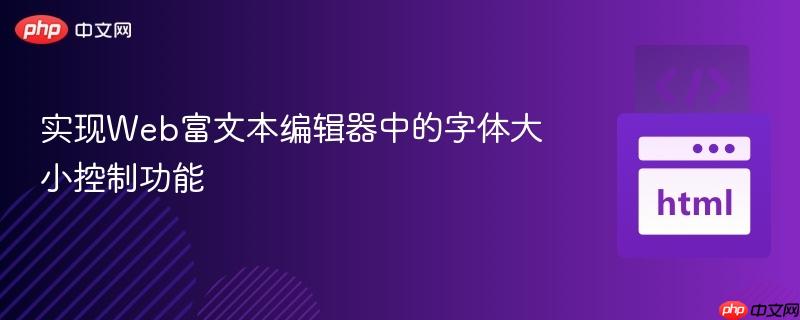
本文详细阐述如何在web富文本编辑器中实现字体大小调整功能。通过集成数值输入框和javascript事件监听,可以动态控制可编辑区域的字体大小。文章着重指出`document.execcommand`的弃用,并提供了基于现代web标准的实现方法,同时探讨了针对选中文字进行样式调整的复杂性及推荐的解决方案。
构建一个功能丰富的Web富文本编辑器,如Google Docs,需要实现多种文本格式化功能,其中字体大小调整是核心之一。本文将指导您如何在基于contenteditable的编辑器中添加字体大小控制,并讨论在现代Web开发中应避免的旧有方法及其替代方案。
为了允许用户输入或选择字体大小,我们需要在编辑器界面中添加一个数值输入框。这个输入框将用于接收用户指定的字体大小值。
<input type="number" class="font-size-input" id="fontSize" min="8" max="72" value="16" /> <label for="fontSize">选择字体大小</label> <fieldset class="userInput" contenteditable="true"></fieldset>
在上述代码中:
要实现字体大小的动态调整,我们需要通过JavaScript监听字体大小输入框的变化,并将该值应用到可编辑区域。
首先,在JavaScript中获取对字体大小输入框和可编辑区域的引用:
var fontSizeInput = document.querySelector("#fontSize");
var userInput = document.querySelector('.userInput');接下来,为字体大小输入框添加一个input事件监听器。当用户改变输入框的值时,我们将更新userInput元素的fontSize样式属性。
fontSizeInput.addEventListener('input', function(event) {
// 获取输入框的当前值
const newSize = event.target.value;
// 将字体大小应用到整个可编辑区域
userInput.style.fontSize = `${newSize}px`;
});重要说明: 上述实现方式会将字体大小应用到整个userInput元素,即改变了整个可编辑区域的默认字体大小。这意味着,如果用户在输入框中输入“20”,整个contenteditable区域的文本都将显示为20像素。这与Google Docs等应用中“选择部分文本并改变其字体大小”的行为有所不同。
在旧版Web开发中,document.execCommand是实现富文本编辑功能(如加粗、斜体、下划线、颜色、字体大小等)的常用API。例如,改变选中文字的字体大小可以使用document.execCommand('fontSize', false, value)。然而,document.execCommand已被弃用,不推荐在新项目中使用。
其主要问题包括:
要实现类似Google Docs中“选择部分文本并改变其字体大小”的功能,需要更复杂的DOM操作,通常涉及window.getSelection()和document.createRange() API来精确地识别和操作用户选中的文本。
基本思路是:
这种方法虽然强大,但实现起来较为复杂,需要处理各种边缘情况(如部分选中、跨多个元素选中等)。
对于需要复杂富文本编辑功能的项目,强烈建议使用成熟的富文本编辑器库。这些库通常提供了稳定、跨浏览器兼容且功能丰富的API,能够处理各种文本格式化、DOM操作和用户交互。常见的库包括:
这些库不仅能轻松实现字体大小调整,还能处理图片上传、链接插入、撤销/重做等高级功能,大大简化开发工作。
以下是一个结合了原始问题和答案的优化代码示例,展示了如何添加字体大小控制(全局应用)以及其他基础格式化功能,同时强调了document.execCommand的使用场景(尽管已弃用)。
<!DOCTYPE html>
<html>
<head>
<meta charset="UTF-8" />
<title>富文本编辑器</title>
<link rel="stylesheet" href="index.css" />
<style>
/* 简单的CSS样式,用于高亮和按钮状态 */
body {
font-family: Arial, sans-serif;
padding: 20px;
}
.userInput {
border: 1px solid #ccc;
min-height: 200px;
padding: 10px;
margin-top: 10px;
outline: none; /* 移除默认焦点边框 */
}
button {
padding: 8px 12px;
margin-right: 5px;
cursor: pointer;
border: 1px solid #ddd;
background-color: #f9f9f9;
}
button.inUse {
background-color: #e0e0e0;
border-color: #aaa;
}
.highlight {
background-color: yellow;
}
label {
margin-left: 5px;
margin-right: 10px;
}
.font-size-input {
width: 60px;
padding: 5px;
margin-right: 5px;
}
</style>
</head>
<body>
<!-- 格式化按钮 (使用 document.execCommand,已弃用) -->
<button class="bold" onclick="document.execCommand('bold',false,null);">
<strong>B</strong>
</button>
<button class="italic" onclick="document.execCommand('italic',false,null);">
<em>I</em>
</button>
<button class="underline" onclick="document.execCommand('underline',false,null);">
<u>U</u>
</button>
<!-- 颜色选择器 -->
<input
type="color"
class="color-picker"
id="colorPicker"
oninput="changeTextColor(this.value);"
/>
<label for="colorPicker">文本颜色</label>
<!-- 高亮按钮 -->
<button id="highlight">
<mark>高亮</mark>
</button>
<!-- 字体大小输入框 -->
<input
type="number"
class="font-size-input"
id="fontSize"
min="8"
max="72"
value="16"
/>
<label for="fontSize">字体大小 (px)</label>
<!-- 可编辑区域 -->
<fieldset class="userInput" contenteditable="true"></fieldset>
<script>
// 获取DOM元素引用
var boldBtn = document.querySelector(".bold");
var italicBtn = document.querySelector(".italic");
var underlineBtn = document.querySelector(".underline");
var colorPicker = document.querySelector(".color-picker");
var fontSizeInput = document.querySelector("#fontSize"); // 字体大小输入框
var highlightBtn = document.querySelector("#highlight");
var userInput = document.querySelector('.userInput'); // 可编辑区域
// 按钮状态切换(视觉反馈)
boldBtn.addEventListener("click", function () {
boldBtn.classList.toggle("inUse");
});
italicBtn.addEventListener("click", function () {
italicBtn.classList.toggle("inUse");
});
underlineBtn.addEventListener("click", function () {
underlineBtn.classList.toggle("inUse");
});
highlightBtn.addEventListener("click", function () {
highlightBtn.classList.toggle("inUse");
});
// 文本颜色改变函数 (使用 document.execCommand,已弃用)
const changeTextColor = (color) => {
document.execCommand("styleWithCSS", false, true); // 确保使用CSS样式
document.execCommand("foreColor", false, color);
};
// 字体大小改变函数 (应用于整个可编辑区域)
fontSizeInput.addEventListener('input', function(event) {
const newSize = event.target.value;
userInput.style.fontSize = `${newSize}px`;
});
// 高亮功能 (通过DOM操作实现)
document
.getElementById("highlight")
.addEventListener("click", function () {
var selection = window.getSelection();
if (selection.rangeCount > 0) {
var range = selection.getRangeAt(0);
var span = document.createElement("span");
span.className = "highlight";
span.appendChild(range.extractContents()); // 提取选中内容
range.insertNode(span); // 插入带高亮样式的新span
}
});
</script>
</body>
</html>在Web富文本编辑器中实现字体大小控制是提升用户体验的关键功能。虽然简单的全局字体大小调整可以通过直接修改contenteditable元素的CSS样式来实现,但要实现类似Google Docs中针对选中文字的精细控制,则需要深入理解Selection和Range API,或直接采用功能强大的第三方富文本编辑器库。同时,始终牢记document.execCommand的弃用状态,并优先选择更现代、更健壮的Web API进行开发。
以上就是实现Web富文本编辑器中的字体大小控制功能的详细内容,更多请关注php中文网其它相关文章!

每个人都需要一台速度更快、更稳定的 PC。随着时间的推移,垃圾文件、旧注册表数据和不必要的后台进程会占用资源并降低性能。幸运的是,许多工具可以让 Windows 保持平稳运行。

Copyright 2014-2025 https://www.php.cn/ All Rights Reserved | php.cn | 湘ICP备2023035733号